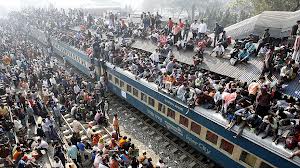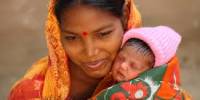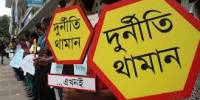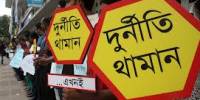Introduction
Bangladesh, the seventh largest (152.51millions in 2011) and one of the most densely populated countries (1015 persons per sq. km) in the world has started to experience another emerging issue of population ageing in its highly vulnerable population and development context (Population & Housing Census Report 2011).
In Bangladesh, the statistical data represent that from the year 1974-2001 the number of aged population has increased from 1.38 million to 6.05 million and 7.59 million of the total population are aged (BBS, 2003).
Population ageing is defined as an increase in the proportion of population, which is elderly. There is no universally accepted definition of the elderly but, in most gerontological literature, people above 60 years of age are considered as ‘old’ and taken to be the ‘elderly’ segment of the population of a country. In Bangladesh, persons aged 60 or above are considered to be elderly. However, in reality people in this country become older before the age of 60 because of poverty, physical hard working and, inability and illness due to malnutrition and geographical condition. (http://www.unnayan.org/reports/Policy%20Brief%20on%20Elderly%20Population.pdf).
Demographic Situation of the Elderly
Ageing of the population is one of the most important demographic facts that came to the foreground in the 21st century. With the increase in life expectancy of the world population ageing is now a global issue. It is common all over the world that elderly age range is increasing rapidly and on the other hand the number of children and youth population is decreasing. In 1950, the number of world population of age 60 years and above was about 200 million, constituting 8.1 %of the total global population. In the year 2050, there will be a manifold increase; the world’s elderly population is projected to be 1.8 billion which is about 20% of the total 9.8 billion. The annual rate of increase of population is 1.5%, whiles at the same time the rate of increase of the elderly population of age 60 + would be 2.5% (http://www.un.org/esa/population/cpd/cpd2007/Country_Statements/Bangladesh.pdf).
Table-1: Population Aged 60 years or Older: World &Major Regions
| Country or Area | Population Aged 60 years or Old | ||||||||||
| Number (millions) | Percentage of total Population | Percentage living alone | 60 and above population percentage in labor force | Percentage currently married | Sex ratio (Men per 100 women 2006 | ||||||
| 2006 | 2050 | 2006 | 2050 | Men | women | Men | women | Men | women | 60+ | |
| World | 687 | 1968 | 11 | 22 | 8 | 19 | 40 | 16 | 80 | 48 | 82 |
| More developed regions | 247 | 400 | 20 | 32 | 13 | 32 | 22 | 11 | 79 | 48 | 72 |
| Less developed Regions | 440 | 1568 | 8 | 20 | 5 | 9 | 50 | 19 | 81 | 47 | 88 |
| Least Developed Countries | 39 | 171 | 5 | 10 | 4 | 8 | 71 | 37 | 85 | 39 | 85 |
| Africa | 48 | 192 | 5 | 10 | 6 | 11 | 64 | 32 | 85 | 39 | 83 |
| Asia | 34 | 1231 | 9 | 24 | 5 | 9 | 48 | 18 | 81 | 50 | 88 |
| Europe | 151 | 225 | 21 | 34 | 13 | 35 | 15 | 7 | 80 | 47 | 69 |
| Latin America and the Caribbean | 50 | 188 | 9 | 24 | 7 | 10 | 46 | 16 | 75 | 42 | 82 |
Source: United Nations Population Division, 2007
Population ageing is increasingly recognized as a process of major significance for all society. Table -1 show that, how rapidly increase world population. The issue of living alone in old age is also considerable as in more developed regions, there are only 13 percent men living alone at old age in 2006 compared to 32 percent women. In less developed regions these figures are 5 percent and 9 percent for men and women respectively (See table-1).Aged people 60 years or over, who currently married, in more developed regions, 79 percent are men and 48 percent are women. Thus, a large proportion of older women at are 60 over are widowed, divorced or separated, which of course put these women in vulnerable position.
In world, the elder people ratio is difference between developed and developing countries. In developing countries, the proportion of older persons is expected to rise from 8 to 19 per cent by 2050, while that of children will fall from 33 to 22 per cent. Though developed countries have been able to age gradually, they face challenges resulting from the relationship between ageing and unemployment and sustainability of pension systems, while developing countries face the challenge of simultaneous development and population ageing. There are other major demographic differences between developed and developing countries. While today the overwhelming proportion of older persons in developed countries live in areas classified as urban, the majority of older persons in developing countries live in rural areas. Demographic projections suggest that, by 2025, 82 per cent of the population of developed countries will live in urban areas, while less than half of the population of developing countries will live there. In developing countries, the proportion of older persons in rural areas is higher than in urban areas (social.un.org/ageing-working-group/documents/mipaa-en.pdf).
Developing countries like Bangladesh the elderly population is also increasing in a remarkable rate. The table below shows the trend of increase in the number of elderly persons in Bangladesh.
Table-2: The trend of increasing number of Elderly in Bangladesh
| SL.NO | Age group | Population census of 1974 | Population census of 1981 | Population census of 1991 | Population census of 2001 |
| 1 | 55-59 | 1351885 | 1620374 | 1949721 | 2356440 |
| 2 | 60-64 | 1682629 | 1948649 | 2270142 | 2828640 |
| 3 | 65-69 | 735255 | 901571 | 1092919 | 1443140 |
| 4 | 70+ | 1639056 | 2053133 | 2339704 | 3318560 |
Source:http://www.un.org/esa/population/cpd/cpd2007/Country_Statements/Bangladesh.pdf
Table-3: Number,Percentage of National &Elderly Populational,1951-2008
Year | National population | Elderly population | ||||
Number (in millions) | Growth Rate | Number (in millions) | Variation | Percent | ||
Number | Percentage | |||||
1951 | 44.17 | 0.50 | 1.94 | ……. | …… | 4.4 |
1961 | 55.22 | 2.26 | 2.87 | 0.93 | 47.94 | 5.2 |
1971 | 76.40 | 2.48 | 4.35 | 1.48 | 51.57 | 5.7 |
1981 | 89.91 | 2.35 | 4.95 | o.60 | 13.79 | 5.5 |
1991 | 111.46 | 2.17 | 6.02 | 1.07 | 21.62 | 5.4 |
2001 | 130.52 | 1.59 | 8.09 | 2.07 | 34.39 | 6.2 |
2008 | 144.66 | 1.4o | 9.69 | 1.60 | 19.77 | 6.7 |
Source:1)BBS,2009,Report on Sample Vital Registration System,20082)BBS,2007,PopulationCensus2001,National Series,Volume-1,Analytical Roport,P-32-33,68
Bangladesh is one of the most populous countries in the world and is projected to remain in the same position in 2050. The percentage increase of the elderly population has a slow but steady increase during 1951 – 2008 periods. Although the percentage increase is not that high (from 4.4 to 6.7) during 1951 – 2008 periods, the increase of the absolute number of the elderly people is absolutely alarming. The absolute number of the elderly population has increased from 1.94 million in 1951 to 9.69 million in 2008. The national population has about 3.27 fold increase whereas the elderly population has a 5-fold increase during 1951-2008 periods.
Table 4: Elderly support Ratio, Ageing Index & Median Age, 1951-2001
Year | Dependency Ratio | Index of Ageing | Median Age | |
Total | Elderly | |||
1951 | 87 | 8.2 | 10.45 | 19.3 |
1961 | 105 | 10.7 | 11.30 | 17.6 |
1971 | 116 | 12.3 | 11.87 | 15.9 |
1981 | 109 | 11.6 | 12.08 | 17.0 |
1991 | 102 | 11.0 | 11.96 | 18.0 |
2001 | 83 | 11.2 | 15.90 | 20.69 |
Source:BBS,2007,Bangladesh Census Results at a Glance,http://www.bbs.gov.bd/p-3
(www.inia.org.mt/data/images/bold/Bold_August_2011.pdf).
The three most important demographic indices of population ageing are old age dependency ratio or elderly support ratio, index of ageing and median age have shown a positive increasing trend over the periods. These trends have been rightly corresponding with the emerging issues of population ageing in Bangladesh. Although the total dependency ratio had decreased through ups and down processes to 83 in 2001 from 87 in 1951, the elderly support ratio has increased from 8.2 in 1951 to 11.2 in 2001. Index of ageing has increased from 10.45 in 1951 to 15.90 in 2001, which is more than 50 percent increase. Median age has increased from 19.3 in 1951 to 20.69 in 2001. The high median age in 1951 was 19.3 may be due to the heavy migration during the independence and partition of the Indian subcontinent in1947. The increase of median age is evident when we look at the 1974’s median age which was 15.9 year and it has increased to 20.69 year in 2001.
Source: World Population Prospects 2009.
This figure, we see that the percentage of the elderly in Bangladesh is increasing with the advancement of time. The percentage of the elderly population in 2050 might be about three times higher than the percentage in 2000. The key point here is that the elderly population keeps growing and will continue to grow. The percentage of the elderly population has steadily and slowly decreased over the past half century (Figure 1), which was 6.2 percent in 1950, 5.5 percent in 1975 and 4.9 percent in 2000.
Socio-economic situation of the elderly in Bangladesh
Bangladesh is basically a rural country and 80% of its population lives in rural areas. Therefore, 80% of the elderly of the country live in the rural areas. In rural areas socio-economic problems are high and in urban and semi urban areas social problems also exist. Some micro-level surveys in urban and rural areas made by the Bangladesh Association for the Aged and Institute for Geriatric Medicine reveal a depressing situation of the elderly population particularly in respect to their health and economic situation. The survey also showed that most of the elderly live in joint/extended families and they had so far been mainly supported by their adult children. But due to deteriorating economic conditions this support does not last long. Besides now-a-days women are involving without side activities, therefore the elderly are not being cared properly by them (National Plan, 1997).
In Bangladeshi families most of the elderly sometimes hold important role. So household decision making is indicative of older person’s status and authority. The 1998 ESCAP survey reports 49.6% of older males in rural areas play a dominant role in making major or most household decision. Older females from rural areas report that 34.7% of the major decisions are made by their sons (Samad and Abedin, 1998).
Over time values for the elderly people are changing and young groups are not paying respect to the elderly rather they feel them as burden for them, poor family education is an important reason beyond this because young and children are not taught to respect the old people.
It is universal that elderly are one of the victims of poverty and dependency. Although elderly man possess some property but elderly women are barely penniless. Their main problem is economic. They have no capability of earning. Generally elderly women in middle class family of Dhaka city depend on their sons or husband. As a middle class member they are not enough capable to fulfill the inherent high ambition.
Economic situation of the elderly is very vulnerable. In general older people feel that young people see them as being unable to earn income, dependent on their families for survival, and therefore as a burden.
About 80% people of elderly are in rural areas. In rural areas where social and technological changes are less rapid, many younger people did not value the contributions of older people to the family and community. In rural area job facilities are low and young people do not get the chance of job always let alone the elderly. In urban areas there are some private companies where elderly can work but the percentage of the institutes is very low in comparison with the required numbers of institutions.63% elderly people were jobless where as only 15 and 14% of them were continuing with age works and business respectively (Kaldi, 2005). Another survey shows that 46% of the people are capable of working but not getting the job scopes and about 15% of them are not totally qualified to do anything.
www.scialert.net/fulltext/doi=jas.2010.3060.3067&org=11).
The majority of activities zone by older persons in Bangladesh are agricultural work and household chores. Household tasks, described as non-income generating work, are for the most part performed by females. For older females, the survey reports that majority of them doing cooking (8.5%), cleaning (69%), laundry (70%) and reports that their children buy the food (76.1%), pay the bills (68.9%), and take care of the property (70.8%) (Samad and Abedin, 1998).
A negligible percentage of the elderly get a formal pension or a minimum old age allowance, the vast majority will have to depend on their family members or on other sources. These economically dependent elderly parents and grandparents will become a burden on the major portion of the working age population of 40-54 age groups who at the sometime will have to shoulder the responsibility of their children also (Kabir, 1998).
Health Situation of Elderly
The health condition of elderly is not so good to be satisfied. They possess broken and ill health in absence of proper health care needs and facilities. The older or the people above 50 years have two kinds of diseases: (i) short term diseases (ii) long term diseases.
Short term diseases are cold, caught, fever, digestive disorder etc. which may be rendered with as usual medicines and going to doctor is not needed. Another is long term disease which is chronically and doctor’s suggestion and care are must. The diseases are such as, Heart disease, Diabetes, Dementia, Enlargement of prostrate etc (Mojlish, Romjan Ali Khan, 1992).
They also suffer from gerito urinary disease, mental disorder and malnutrition. Blood pressure, diabetes and cardiac disease area more common chronic health conditions among urban elderly where as pain, rheumatism, anemia and respiratory problems are more common in rural elderly old odds 9age-70+) compared to young old, 9age, 60-70 years) females compared to males, rural elderly compared to urban elderly have great problems with functional activities like couching, lifting, walk etc (Begum, 2008).
Social and economic dependency also impact on health. Many young members reported that older people are very much fussy about their health, need and personal services, due to high cost. Many elder people delay seeking medical attention care and until they are extremely ill, thereby prolonging illness.
Old people aged above 65 years are having an increased threat for disease due to poor diet and inadequate physical activity. Here most of the elderly suffer from shortage of eyesight even lose the eyesight; listen a little, ways of their walking becomes very short as they cannot walk more. They generally use stick to continue their walking. In most cases their teeth are not eligible to eat something and most of the teeth fall down at the beginning of their old age. Sometime they are not able to run their lives easily. So they need the help from others to go to toilet, bathroom or to sit or walk. They are not spending the required amount of money on healthy food, leisure centre visits, dental and eye care costs. So they suffer from various disease and sicknesses which are common for elderly.
Medical services are limited in Bangladesh & thus lead to greater health problems for the elderly .There are only 419 Govt. Hospital, 21,000 registered doctors, 8,500 nurses, & 6,000 qualified paramedical (BAAIGM, 1997). As a part of a vulnerable group, the older population has a greater need for, but less access to health care.
Elders face depression on and related mental health disorders, including anxiety & schizophrenia.
The following symptoms arise when a person become old aged: Strong, repeated concerns about death and dying, an unexplained change in behavior, a tendency to frequent arguments and bad moods, avoiding people, feelings of anxiety around people, finding no pleasure in doing things he or she used to enjoy, feeling hopeless or worthless etc( Begum, 2008).
Available Services of the Elderly in Bangladesh
In Bangladesh, services for the elderly have been limited. Some limited efforts have been at public initiatives towards alleviating the situation of the elderly in the country. Two types of care and service systems are available in Bangladesh for the elderly – traditional or indigenous, and modern. Traditional services include care by the family or relatives, charity or alms giving, and permission to live in religious premises such as mosques, graveyards, mazars, and dargas. Modern services are offered by both governmental and non-governmental initiatives.
Government Initiatives
Steps taken by the Government of the People’s Republic of Bangladesh on the issue of older persons in accordance with the MIPAA are-
Pension and other Financial Policies for the Retired Government Employee:
Government has a pension system for its retired employees since the British rule in 1924. Retirement age in government services is now 57 years. However, the age of retirement is higher in some autonomous bodies as well as in some specialized bodies like judicial department, educational institutions. etc. Pension rules were modified after the end of the British rule in 1952 and later it was modified again in different stages in 1972, 1974, 1977, 1982, 1985, 1988, 1989, 1991 and 1994 after the independence of Bangladesh in 1971. (Mohiudin, M. And Islam, M.N. 2002). At present, generally, a government employee gets 32, 48, 64 and 80 percent of the basic salary as the pension after retiring or at death at the 10th, 15th, 20th and 25th year of his/her employment respectively. There are different types of pension such as Compensation Pension, Invalid Pension, Retiring Pension, Optional Pension, Family Pension (Rahman, M.H. and Parveen, F. R., 1999).
Constitution of the Country
The rights of the elderly are mentioned in the Constitution of the People’s Republic of Bangladesh. The rights to social security through public assistance in cases of unsaved want arising from ‘old age’ along with unemployment, illness or disablement, or suffered by widows or orphans or in other such cases are mentioned in the Section 15 (d) entitled ‘Provision of Basic Necessities’ of the Part II of the constitution entitled ‘Fundamental Principles of State Policies’ The provision of basic necessities for all citizens such as food, clothing, shelter, education and medical care; the right to work and employment at a reasonable wage and right to reasonable rest, recreation and leisure are mentioned in the 15 (a), 15 (b), 15 (c) clause respectively in Section 15 of the constitution. (http://www.pmo.gov.bd/constitution).
National Policy on Ageing
National Policy on Ageing (NPA) has been a demand for a long time by the people and organisations concerned with the welfare of the elderly people. The policy has already been approved at the ministerial level in 2007. NPA has been formulated in the line of MIPAA’s policy (Country Report of Bangladesh, 2007). People aged 60 and over are defined as the elderly citizen of the country in this policy. The main objectives of this policy are:
- To ensure the dignity of the elderly people in the society.
- To identify the problems of the elderly people and address those.
- To change the attitude of the mass people towards the elderly people.
- To take new programmes to address the needs of the elderly people for their socio-economic development.
- To develop special measures to help the elderly peoples during emergency like natural calamities, cyclone, earthquake etc.
- To ensure social security, health care, employment and rehabilitation.
- To implement the Madrid International Plan of Action on Ageing (MIPAA)
(http://www.un.org/esa/population/cpd/cpd2007/Country_Statements/Bangladesh.pdf).
National Committee on Ageing
The national Committee on Ageing was constituted for the first time after the Vienna International Plan of Action on Ageing in 1982. It was one of the first moves from the government level to address the ageing issues from a formal point of view. The President and Vice President of the committee were the Minister and Secretary of the Ministry of Social Welfare, Government of the People’s Republic of Bangladesh respectively. The committee played some role to allocate some fund for the Bangladesh Association for the Aged and Institute for Geriatric Medicine (BAAIGM). Primarily this committee was involved in formulating policies and its implementation for BAAIGM (South-South Centre, 2004).
Old Age allowance programme
This pension programme for the poor older people for the first time in the country was inaugurated by the Prime Minister of the country on 31st May 1998 under the Fifth Five Year Plan. Initially Taka 125 million was allocated for this scheme. 10 elderly poor, of whom at least 5 should be women of each ward of a union throughout the country were sanctioned a monthly allowance of Taka 100 each.
Later the coverage and amount of money were increased in ten successive fiscal policy of the successive government. Although the coverage has increased significantly, only 23 percent of the older people of the country are currently getting this benefit. Table 4 shows the increasing coverage and amount of this scheme. This programme was found to have immense multidimensional positive impacts on the recipients, recipient’s family and also on the rural society as a whole (Majumdar, P. Pal, and Sharifa B., 2001).
Table 4: Old Age Allowance Programme in Bangladesh (1997-2009)
Year | Total Allocation(Taka* in millions) | Number of Beneficiary(in millions) | Taka Per Person (per month) |
1997-1998 | 125 | 0.403 | 100 |
1998-1999 | 425 | 0,403 | 100 |
1999-2000 | 500 | 0.413 | 100 |
2000-2001 | 500 | 0.415 | 100 |
2001-2002 | 500 | 0.415 | 100 |
2002-2003 | 750 | o.5 | 125 |
2003-2004 | 1800 | 1.0 | 150 |
2004-2005 | 2603.70 | 1.315 | 165 |
2005-2006 | 3240 | 1.5 | 180 |
2006-2007 | 3480 | 1.6 | 200 |
2007-2008 | 4485 | 1.7 | 220 |
2008-20092 | 6000 | 2.0 | 250 |
2009-2010 | 8100 | 2.25 | 300 |
*1U$=70 Taka
Source: 1)GOB,2007,Poverty alleviation, Human resource Development & Ministry of Social Welfare,P-75
2)Budge Documents2009-2010,Safty Nets,2009-2010.available at:http://www.mof.gov.bd/en/budget/09_10/safety_net/bn.pdf
National Health Policy
The emerging issues of the elderly are mentioned as a ‘current and upcoming challenges’ in the Government’s draft national health Policy, 2008. The goals of this policy are in accord with the goals of Poverty Reduction Strategy Paper (PRSP) as well as Millennium Development Goals (MDGs) where sustainable improvement in health, nutrition and family welfare status of the people, particularly of the poor and vulnerable groups including women, child and the elderly were addressed along with their economic and social emancipation (GOB, 2008).
Five Year Plans
Government’s planning as well as concern for the welfare of the elderly people was first found in the Third Five Year Plan (1985 – 1990). In Third Five Year Plan, awareness of planning in this regard was influenced by the Vienna International Plan of Action on Ageing in 1982 as well as the UN’s conference on ‘The World Ageing Situation, Strategies and Policies’.
Then some concrete initiatives were taken for the welfare of the elderly people in the Fourth Five Year Plan (1990-1995). Taka Five million (1U$ = 70 Taka) was allocated for the first time under the Ministry of the Social Welfare although the money was not expended.
Fifth Five Year Plan (1997 – 2002) plan proposed to establish more centres for older persons with facilities like light economic/ income generating activities, geriatric medical and social welfare services for the poor older people. The most basic and innovative policy for the poor older people in Bangladesh, the ‘Old Age Allowance Programme’ (Boyoshko Bhata Karmaschuchi) was formulated in this Fifth Five Year Plan (1997 – 2002).
(www.inia.org.mt/data/images/bold/Bold_August_2011.pdf).
Non-Government Initiatives
non-GOVERNMENT ORGANISATIONs have programmes directed specifically at old people. However, their services are confined to outdoor and indoor medicare, maintenance of oldman’s home, recreation facilities for the old people and seminars, workshops, training, research and publication activities. Despite having 1500 NGOs in the country, it is very difficult to say how many are working for the cause and interest of the elderly. Some notable ones are identified below:
Bangladesh Association for the Aged and Institute of Geriatric Medicine (BAAIGM), is the prime non-government organization at national level working for the welfare of the older persons in Bangladesh. Established in 1960, the Association provides services to the elderly in different forms like health care services, recreational and socio-economic activities, 50 bed geriatric hospitals with out-door programs and pathological services, recreation and library programs, vocational training and management of revolving funds and research and publication.
Elders and Children Rehabilitation Centre for the elderly was by an individual in set up in 1987, at Gazipur. They are given free accommodation, food, and clothing and medicare facilities. The elders are involved in gardening, farming, piciculture and other recreational activities.
Resource Integration Center (RIC) got involved with the elderly welfare activities through working relief activities during the floods in 1988 (RIC, 2003). This organisation has started micro-credit programme with some 150 elderly people with the help of Help Age International and Action Aid, Bangladesh in 1989.. RIC’s activities included housing and health care facilities, recreation, funeral support and pension along with micro credit programme.
Service Center for Elderly People (SCEP), provides health service and recreational facilities to the older persons of age 60 and more for their social and emotional peace. Present activities of the SCEP for the registered elderly include listening to the radio, watching television, reading newspapers, magazines, playing indoor games.
Elderly Initiatives for Development (EID) was established at Manikgani, a nearby district headquarters of Dhaka in 1995, as a community based self help organisation. Its activities included health care, continuing education, financial support and services, psychological support and community awareness creation (Samad, A., 2005).
Bangladesh Retired Government Employees Welfare Association was established in 1955 in Dhaka to render benefit and service to government pensioners and their family members, run vocational training facilities organize recreational facilities for older members and respective families, provide accommodation to pensioners having no such provision and to arrange health care facilities for pensioners and their family members.
Very recently, Bangladesh Women’s Health Coalition (BWHC), Bangladesh Girl Guides Association, Bangladesh Education Board Retired Employee Welfare Association, Old Home and Bangladesh Society of Gerontology and Forum for the Rights of the Elderly are also working for welfare of elderly. Thus, limited number of NGOs and professional associations are working for the welfare of the elderly.
Prospects
“Death of an older person is the end of a library.”(China proverb)
Elderly are on such a situation which reaches at that position after passing a huge time working for them and their families. Once they have physical, mental and economic well off situation but over time they lose their physical as well as mental power gradually. At that time they can do hard labor a little bit but they can think very sharply along with they can understand or percept anything very quickly. Sometime it is said that elderly people get fear very much and they do not want to take challenges which is totally wrong to the renowned persons such as Bertrand Russell who married for 4th times at the age of 70 and still his dealt at the age of 90 he wrote books. Pablo Picasso who died at the age of 83 but he didn’t stop his work before his death. Sher-E-Bangla A.K. Fazlul Haque who died at the age of 80 was not a burden for the family, society or for the nation. Dr. Muhammad Shahidullah, Poet Al-Mahmud Poet and writer Syed Ali Ahsan, Professor Kabir Chowdhury, who died after 70 years even more than 80, years (Mojlish 1992).
Therefore we cannot consider the elderly people as unproductive sector; they may be a great hill of light which will guide all people around the hill. Elderly are promising but we have to them facility and utilize them.
Promising sectors of elderly people
Advocacy: Elderly can advocate their clients. Elderly people who are lawyers can serve their client from their long-experience. Especially elderly lawyers are renowned in their profession.
Preserving National Art: A little review shows that heritage of our national art of cooking, Art of sewing, art of pottery, art of weaving, jute industry etc. Fine arts and handicrafts are going to be lost due to ultra modern touch. In order to save and preserve those, our old people (male and female) who are well experienced be deployed (Salma, 1999).
Care taker and story teller: Now-a-days both father and mothers are busy with various activities in house and outside the house. So the elderly can pass their time by looking after the grand children. They also love it and the grand children also love to be with their grandfathers and grand mothers. They can educate the children through gossiping, telling stories and making fun with them. Here very important fact is telling story. Because these stories will be create the thinking, beliefs and values of the children. If the stories are of humanity, brevity, forgiveness and in one word of good behavior they will be like those characters.
Teaching: The elderly are more experienced in teaching profession. They can easily understand the student because of their long time experience. So their teaching is more effective for the student.
Medification: Now a day’s doctors and patients are given advice how to overcome stress about the diseases. In this case elderly are the most preferable groups in the society. When they will talk with the patients, the patients will get mental power. Not only this but also they can suggest the policy makers by imparting their experiences felt at the time of diseases attack and remedial period.
Encouraging: Elderly encourage us and hope our regard. That is to say, we can sacrifice our life in development activities by being self-confident for their encouragement.
Experience: Elderly people are for sighted experienced. They can help us by their experience. They can cursed advise and order for the betterment of youth. Our inexperienced conscious people may gather experienced from them. In this way our next generation may turn into a skilled working force.
Not only these but also they can conduct small business shops, small business related activities. They can be counselor, psychologist and sex educator which are crying need for our country because our culture is somewhat shy to say these things to the adults but for the shortage of clear sense of this knowledge, adults are abusing their physical, mental and intellectual powers.
Beside this, if the elderly get enough suitable opportunities, then, they can contribute like other. Below- mentioned initiatives can be taken for them.
- Initiative should be under taken to foster the development of local financial services including micro-credit schemes and micro-financed institution.
- Government has to shoulder primary responsibility in enriching and ensuring the sustainability of ongoing social protection system (Rahman, 2002).
- Bangladesh government needs to declare those citizens of 60 years and above through legislation as senior citizen. This will enable them to enjoy some privileges as are being practiced in different countries. Similarly legislation should be enacted so that the children should not neglect their older parents willfully.
- Older persons must be allowed as full participants in all the national and development activities and also share in its benefits.
- Health education programs have to be strengthened in mass media, cultural activities and general education curricula. Young and middle-aged people need to be sensitized the taking balanced diet, doing regular exercise and health cheek-up (Rahman, 2004).
- Steps are to be taken to introduce home care, day care and community based care programs for covering all groups of older persons in the country.
- Support of mass media is indispensable as it is the harbinger of societal changes.
- Development partners, BGOs, honor agencies, civil societies, corporate bodies etc. should come forward, be more active and continue playing sincere role of complementing and supplementing the government run age care programs and services in Bangladesh. Moreover they should endeavor to undertake different elderly welfare project such as health, income generation, housing, socio-economic, recreation services to meet the felt needs of older persons (BAAIGM, 2005).
Conclusion
Elderly populations are the asset of any nation. They have experience, wisdom and knowledge which can be used for the national reconstruction. It is the responsibility of everyone to take care of our national asset and utilized their experience. Elderly is a serious reality and last step of our life cycle. So it is the responsibility of our nation to come forward for the wellbeing of our respected senior citizen of Bangladesh. To achieve this mission, it is very important to educate people and to build more awareness among people. Older people should be regarded as valuable human resources as they doing huge services at home and outside. Their residual capacity and rich experience should be properly utilized for the overall socio-economic development of the society. Their ability to lead productive, healthy and meaningful lives should be ensured by the younger generations and the government respectively.















